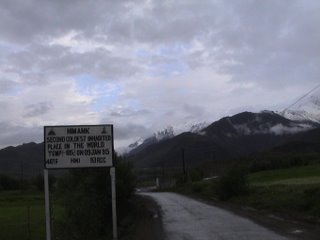We’d only heard of Drass as a militant-infested district of Kashmir. What we didn’t know was the fact that Drass is the second coldest inhabited place on earth. There is a signboard stating “Drass… 2nd coldest… -65 C… Jan 1995” welcoming us to the town. Joy spent an hour, filming and photographing the stat-board from all possible angles. I think that stat is going to be the highlight of his doc film. Given that Drass is not particularly high up, it’s hard to imagine that -40 C is common during the winters. The place has a gloomy look to it, with dark clouds hovering above and a certain dampness in the air at all times.
That was the last of the cold nights. We woke up early, and found that the bathroom had a glass window the size of a door. While the idea of having a good, panoramic view is appreciated, they forget that the view is two-way. Anyway, the view happened to be that of Tiger Hill – the strategic peak that India lost and recaptured during the Kargil War.
While at the cramped hotel in Drass, we met a Brit who suffered from a colonial hangover. He passed generalized nasty comments demeaning advertising professionals, which annoyed Gopal. He never missed an opportunity to point out how everything (eg : Royal Enfield) is from Briton and that nothing has changed after independence. We felt enraged and sincerely prayed that he meets with an accident, hopefully in some godforsaken place like that old abandoned road near Lamayuru.
Negative thoughts aside, fresh snow is a treat to the eyes. It looks like someone strewed fine white talcum dust from top. So, early next morning, as we rode on to Zojila pass, we ogled at the dark peaks capped with fresh snow. I remember mocking at the name Zojila during 8th class geography classes. Never did I dream that I’d land there someday. Being a damp day, we rode on slush and loose earth, but crossing Zojila (~13,000 ft) was a piece of cake compared to the high passes of Ladakh.
We halted at an army check post, and the wonderfully polite chaps invited us for tea. Hot chai in a steel tumbler was the perfect antidote to the numbing cold that had bothered us all morning. As we looked down at the valley, we saw thousands of little tents littered all over, for the Amarnath Yatra. The army guys were shocked that, having traveled so far, we didn’t intend to check out the Amarnath Yatra. Joy threw this don’t-you-know-I’m-interested-in-stats look, not making an effort to hide his disgust at the idea. I tried explaining how we’d been thru so much emptiness and sheer natural beauty in Ladakh, that we were really not interested in crowded places of religious interest. But my struggles with Hindi meant that Gopal had to come to my rescue and he mentioned some non-existing train, which we had to catch two days later.
As we rode downhill, the road improved rapidly, and before we knew it, the roads were 30-40 feet wide, neatly laid… and swarming with steely-eyed army jawans holding AK-47s. Welcome to Kashmir.


